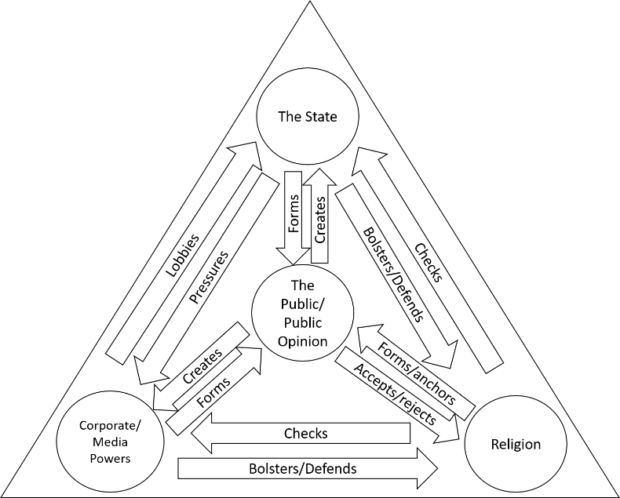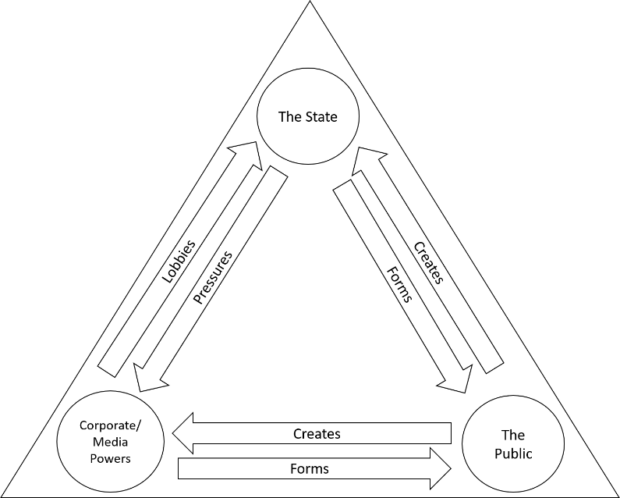'LGBTQ+ ideology has spread so far and so fast on the wings of corporate and state investment.' And a collapse of Burke's 'Little Platoons'.
From Crisis
By Adam Lucas, STM
The deep roots of our current social crisis lie in failed subsidiarity.
As my eyes endure another Pride Month, I’m struck by the scope of a movement that barely two election cycles ago was opposed by the majority of Americans. At least once a year, our entire society is covered in more glitter and rainbows than a 7-year-old girl’s birthday party. Recent pushback notwithstanding, Pride is everywhere—in our stores, our schools, our billboards, our churches, and even our crosswalks. It’s treated as a decidedly settled topic. Opposition to the LGBTQ+ agenda is incredibly unpopular and not tolerated in our institutions.
All of this in less than twenty years (doesn’t anyone remember Obama in 2008?). Christianity didn’t achieve such spread for hundreds of years. Even Islam’s more, er, aggressive evangelization tactics couldn’t achieve such hegemony in a mere twenty years. It forcefully prompts even the most uninterested to wonder: How did we get here?
The simple answer is staring us in the face all this month; LGBTQ+ ideology has spread so far and so fast on the wings of corporate and state investment. Twenty years of movies, television, advertisements, government-sponsored parades, events, recolored infrastructure, and so on have had their intended effect. How did we get here? Simple: government and cultural agendas.
But those of longer memory are left to wonder how those institutions—corporate and state—became so militant. It didn’t used to be this way. The single biggest cultural whip today—Hollywood itself—used to be a conscious promoter of Christian values.
It was called the Hay’s Code, and it controlled every major picture released from 1934 through 1968. Created by a Jesuit priest and enforced by a Catholic layman, the code aimed to prevent films from “lowering the moral standards” of the audience. While there was plenty objectionable in the Hay’s Code (bans on interracial marriage come to mind), for the most part it worked. American media in the 1940s and ’50s still has a reputation for pure optimism and simple virtue, if anything to a fault.
Amazingly, the code wasn’t a government imposition. It was self-censorship from movie studios, brought about by religious activism and even the personal convictions of executives. But neither was it completely devoid of state action, as a variety of cities and states had censorship boards that created economic pressures on studios to clean up their content.
The Hay’s Code is a snapshot of a well-integrated society. The general public, corporate megaliths, government power, and religious tradition all worked together to uphold a coherent public morality—all according to the principle of subsidiarity.
It is this principle of subsidiarity that has failed us today. But not in the way you think. Most Catholics know subsidiarity prohibits higher powers from overriding more local institutions; but few remember that the definition extends in the opposite direction, which is where our culture has primarily failed.
The Catechism of the Catholic Church defines subsidiarity as such:
a community of a higher order should not interfere in the internal life of a community of a lower order, depriving the latter of its functions, but rather should support it in case of need and help to coordinate its activity with the activities of the rest of society, always with a view to the common good.
Catholics today understand the first part of the definition, as they feel the weight of “higher order” institutions interfering with their daily lives (especially in June). But these higher institutions are only able to interfere with the lower because the higher first failed in the second part of the definition; they failed in their duty to support the lower orders.
Remember again the Hay’s Code. It avoided an unnecessarily high power (say the federal government) coming in and regulating the film industry, instead effectively self-regulating without appeal to an order above that of private business. But it only did so because the higher order (state and local governments) created the conditions for such self-regulation through local censorship boards. The common good of public morality was safeguarded without top-down, heavy-handed state power; but only because bottom-up, small state power moved to support such public morality and the lower-level institutions capable of doing so.
Picture society like a big triangle. Right in the middle is “the public”—their morality, welfare, opinions, and all the other stuff that we might as well dub “the common good.” From this pubic is formed a state as the top of the triangle. And, from the same public, is formed corporate and media entities, in the left corner. Lastly, there is the spiritual pole in the right corner—that is, the religious beliefs and institutions accepted or rejected by that same general public. Confusing?
Well then, consider this hastily constructed visual aid, which I’m sure will be no help at all:

As you see, all four of these realms interconnect. The three corners arise out of the center; but then they, in turn, have an effect on that central public. Individuals and the public at large are formed by economic and cultural expressions; government structure and laws; and spiritual ideas and practices. How people are formed then influences them to recreate those very institutions that continue to form themselves and others—and the entire social body forms a feedback circle (or triangle, as it’s too late now to change my visual aid).
Ideally, this is a virtuous circle reinforcing itself toward greater goods. And with the fixture of the public in the center, it indeed tends that way. Like spokes on a (triangular) wheel, it is very hard for any single entity to get too far removed from the rest. One area might win temporary ascendency, but there are enough interlocking checks and balances to prevent complete domination of any one party.
That is, if society follows the checks and balances.
If there is a weak point in the triangle, it is religion. It depends on the public to adhere to it to have power to check the other arms of society. And without control of the army or the pocketbook, it is in danger without the aid of state or corporate defense. And if it does cease to be a major player (as it indisputably has today), you’re left with another crummy visual aid that’s at least a little less complicated:

There are only three powers at play now, which, off the bat, will give less opportunities for checks and balances. Yet nevertheless, our godless society can still produce a virtuous cycle. Each corner gets checked by the other two, making it still very hard for any one to dominate the rest. Afterall, our own American government functions on a similar model—so it must be alright.
But here’s where the Hay’s Code comes back into play (you forgot, didn’t you). With the invention of modern media, the triangle is no longer three equal powers. The state puts pressure on the public; mass media has a formative force on the population; but the public can’t push back as hard. Especially without a transcendent framework to anchor themselves, the general population is quickly tossed along the waves of corporate and state fancy. The virtuous circle then quickly becomes a vicious one.
The society of the Hay’s Code recognized this unbalance and tried to correct it. But as religion faded, so did its power over corporate schemes; and by the end of the 1950s, mass media was more of a force in the opposite direction, helping to open the floodgates of the ’60s sexual revolution.
And so goes our society today. The loss of religion created a culture in which corporate-state powers dominate public formation. And the loss of religion itself was made possible by the corporate-state powers’ failures to guard and defend religion, as is required by subsidiarity (don’t worry, that’s the end of the triangles).
This sort of reasoning calls to mind debates over integralism. Right-leaning Catholics today argue about religious freedom, pitting Vatican II pluralism against traditionalist confessional states. Anti-liberal voices want an America where Catholicism is the official religion. Mainstream conservative voices just want an America where Catholicism is left alone.
In the gun smoke of such battles, we miss the common ground eroding under our feet—the duties of subsidiarity toward the religious order. Whether states have a duty to acknowledge the particular Catholic religion or not, they must acknowledge religion in general. Even a maximally-pluralistic reading of Vatican II must accept the religious corner of the triangle and the state’s duty to protect and uphold it (see Dignitatis Humanae §6 if you don’t believe me).
Am I advocating for the Hay’s Code? No. Am I advocating for media censorship? Given our current climate, also no. I am mostly just making historical sense of our current predicament. But as any historian desperate for approval will tell you, the lessons of the past teach us an awful lot of the future.
Our higher institutions failed in subsidiarity by leaving lower institutions out to dry. And now, thoroughly brittle, the lower bases of society are being trodden by the same higher powers responsible for their weakening. That is how we got to Pride Month 2024. Eventually, the public will become a plaything tossed about by its overlords, reduced to little more than a set piece in what is really a dual competition between state and economic powers. Unless, of course, we start taking both sides of the virtue of subsidiarity seriously.

No comments:
Post a Comment
Comments are subject to deletion if they are not germane. I have no problem with a bit of colourful language, but blasphemy or depraved profanity will not be allowed. Attacks on the Catholic Faith will not be tolerated. Comments will be deleted that are republican (Yanks! Note the lower case 'r'!), attacks on the legitimacy of Pope Leo XIV as the Vicar of Christ, the legitimacy of the House of Windsor or of the claims of the Elder Line of the House of France, or attacks on the legitimacy of any of the currently ruling Houses of Europe.